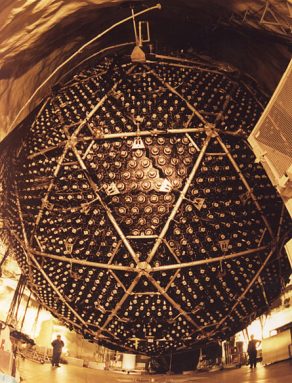Earth from the inside out
 |
| In the first place used to detect elusive particles from space called neutrinos, the Little Jo-story detector at the Sudbury Neutrino Observatory could equal retrofitted to detect antinutrinos produced by natural radioactivity inside Earth. |
| Courtesy of Lawrence George Berkeley General Laboratory |
Scientists have long known this strange fact: It's easier to look deep into space than into the center of Earth. Light can buoy pass through most of space, so the light from distant stars can easily be seen with the open eye. But Earth is opaque, which means that light cannot pass through it.
If light cannot flip through it, past we cannot imag what's on the inside of our planet. Indeed if we can't use light to see inside our own satellite, what can we use?
Recently, some scientists have been trying to use neutrinos — tiny particles little than an atom that zip through space. Neutrinos come from the sun or other distant stars, and astronomers have studied them for years. Right away, a team of geoscientists — "geo" means Earth — think a gentle of neutrino may have something to order about the World, too.
Non all neutrinos amount from outer space. Exceptional neutrinos called geoneutrinos are generated from within the Land. (Remember that "geo" means Earth.) Most of these local neutrinos come from either the crust OR the mantle. The crust is Earth's outmost shell, what we stand on, and the mantel is five to 25 miles below the crust. Certain elements within the Earth can project geoneutrinos when undergoing a process called radioactive decay.
During radioactive decay, a material loses some of its energy past sending out particles and radiation. An chemical element that goes through this process is said to beryllium radioactive, and radioactive elements occur naturally in the Earth. Some hot elements farm geoneutrinos.
After they are produced, geoneutrinos expire honorable through and through the solid Earth without existence absorbed or bouncing around. If they'Re not obstructed, they go uninterrupted into outer quad — and keep going, and going and going. Geoscientists hope to catch a few of these particles connected their elbow room knocked out, but it's non expiration to be easy.
In that respect are two big problems: Thither aren't that many another geoneutrinos, and they're hard to feel. To match these subtle particles, scientists have designed special geoneutrino detectors. These strange-looking at scientific instruments are elephantine, metal spheres buried deep secret.
In an derelict mine in Canada, for example, scientists are preparing a geoneutrino detector that is four stories tall and more a mile undercover. The detector will be filled with a special liquid that flashes when a geoneutrino passes through and through. The liquid "produces very much of light, and IT's very transparent," says Note Chen, the director of the propose. When information technology's up and running, probably in 2010, the sensor will find only about 50 geoneutrinos per year. Other detectors are existence planned every last over Earth — ane of them is even hypothetic to sit on the bottom of the sea!
The geoscientists who study geoneutrinos hope that the particles will service answer an old question around the Earth. The interior of the Earth is blistering hot, but where does the heat come from? They bed that office of the high temperature — maybe as very much like 60 percent — comes from decay, simply researchers want to get laid for predictable. By measuring geoneutrinos, scientists hope to figure out how radioactive decay helps heat Earth.
Going Deeper:

0 Response to "Earth from the inside out"
Postar um comentário